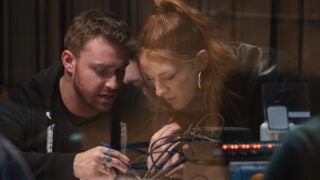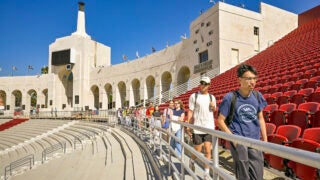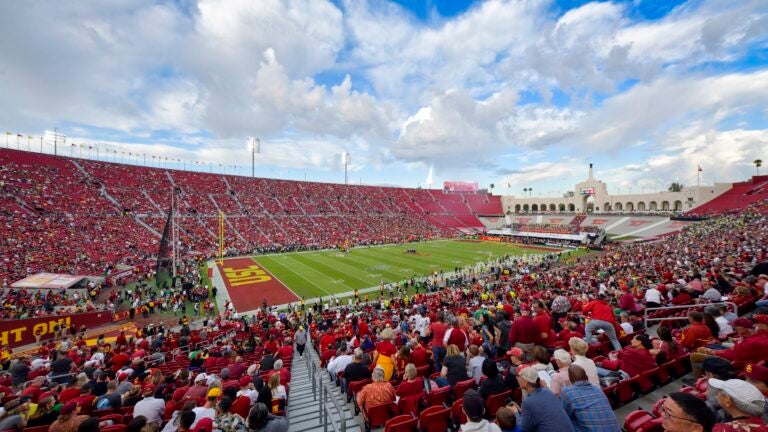
The Los Angeles Memorial Coliseum has been the home of USC Trojans Football continuously since 1923 and under USC management since 2013. It is a touchstone for generations of Trojans who have made lasting memories at the complex. (USC Photo/John McGillen)
Los Angeles Memorial Coliseum marks centennial
The iconic stadium, beloved by generations of USC fans, looks back on a century of sporting, entertainment and cultural history — and forward to the next 100 years.
The Los Angeles Memorial Coliseum — a stadium of world renown in USC’s backyard — has turned 100.
The venerable venue, whose construction was completed on May 1, 1923, has staged some of the world’s most grand public spectacles: From two Olympic Games (soon to be three in 2028), to political speeches by the likes of John F. Kennedy and Martin Luther King Jr., to concerts by mega-acts like U2 and the Rolling Stones, to marvels like ski jumping and Evel Knievel stunts, to historic sports matches like the Super Bowl and World Series.
But to mark its 100th birthday, the Coliseum won’t host just one celebratory spectacle. “Our celebration is not a moment in time,” says Joe Furin ’89, general manager of the Coliseum. “This is an ongoing celebration. It’s a celebration of the past 100 years as much as it is [of] the next 100 years.”
Our celebration is not a moment in time. This is an ongoing celebration.
Joe Furin
Instead of lighting 100 candles on a birthday cake, the Coliseum has been lighting the torch (installed for the 1932 Olympics) atop its famed peristyle on the first of every month since January and will continue to do so for the duration of 2023. All upcoming Coliseum events will include an element of commemoration.
The stadium, which has been the home of USC Trojans Football continuously since 1923 and under USC management since 2013, is a touchstone for generations of Trojans who have made lasting memories at the complex.
“The Coliseum belongs to the world,” said USC President Carol L. Folt. “This historic structure, honoring our Armed Forces who served in World War I, is a treasured part of our nation’s Olympic history, and has been home to Trojan football since 1923. As its steward, USC will ensure it remains a cultural and athletic icon for Southern California and a beloved gathering place for the Trojan Family for generations to come.”
Trojan territory
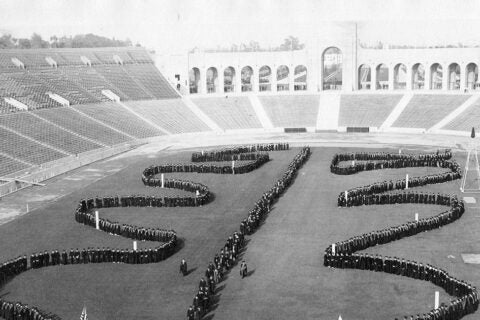
USC has had a stake in the Coliseum’s success since its inception. At the turn of the 20th century, when the Coliseum was a twinkle in city and county leaders’ eyes, the unincorporated area immediately south of the USC University Park Campus was ripe for redevelopment. Saloons, gambling dens and brothels had sprung up on the former fairground site south of the campus.
“As the story goes, the university did not want that [activity happening] right across the street from campus,” Furin says. In response to USC’s concerns, civic leaders agreed to transform the space into Exposition Park, complete with a rose garden, museum and exhibition hall. They proposed building the stadium there, but voters rejected a bond measure that would have paid for it.
To foot the bill for the stadium, city and county officials turned to private funders, who were energized by USC’s embrace of the project. “The president of the university at the time, George F. Bovard, had said, ‘If this gets built, then we will commit for USC [football] to play there,’” Furin says.
USC made good on the promise. On Oct. 6, 1923, just months after the Coliseum officially opened its doors, the Trojans took the field against Pomona College for the Coliseum’s first-ever football game. It was an auspicious beginning: USC romped to a 23-7 victory.
A city on the rise
The debut of the Coliseum was a triumph not just for USC but also for the burgeoning city of Los Angeles. In the early 20th century, “L.A. grew with great velocity,” says William Deverell, a professor of history at the USC Dornsife College of Letters, Arts and Sciences and director of the Huntington-USC Institute on California and the West.
By 1920, Los Angeles had become California’s largest city — surpassing San Francisco in population for the first time — and the motion picture capital of the world. Business was booming, oil was flowing and real estate development was flourishing. But L.A. lacked a central cultural gathering point that could serve both the city’s expanding population and its civic ambitions.
It was a way for L.A. to note to the world: ‘We’ve arrived as a place that takes public space and public events seriously, at a grand level.’
William Deverell
The Coliseum, which was built to seat 75,000 people, provided the proper scale and scope. “It was a way for L.A. to note to the world: ‘We’ve arrived as a place that takes public space and public events seriously, at a grand level,’” Deverell says. The Coliseum became one of several notable L.A. landmarks and institutions that debuted in 1923, including the Hollywoodland sign, the Disney Brothers Cartoon Studio, the Los Angeles Biltmore Hotel and Mexican restaurant El Cholo, a beloved USC hangout.
The stadium helped the city in its bid to host the 1932 Summer Olympic Games. In turn, the Olympics upped the city’s — and venue’s — profiles. “[The Games] were a turning point for the Coliseum to stamp itself internationally as a really significant venue — in a really significant city,” says Jeff Fellenzer, professor of professional practice at the USC Annenberg School for Communication and Journalism and an expert on sports, business and media.
Something for everyone
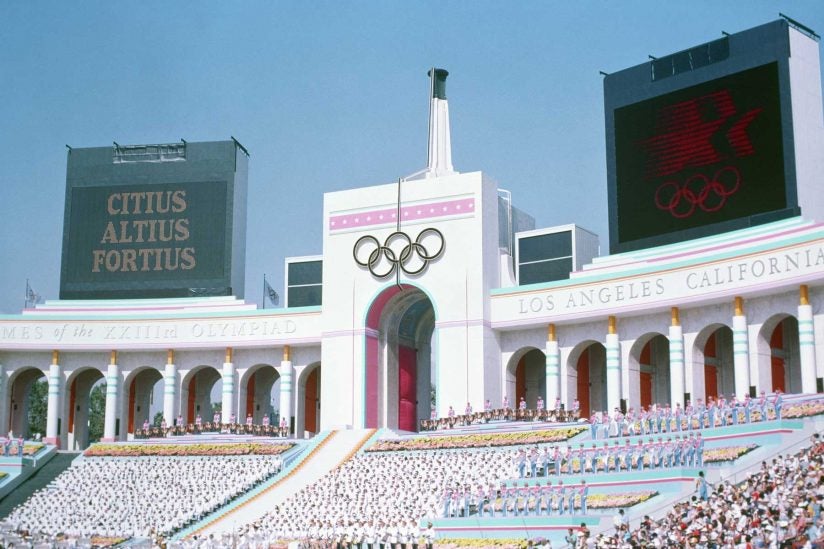
As the decades unfolded, the Coliseum cemented its stature by attracting a staggering roster of high-profile cultural, political and religious figures as varied as Charles Lindbergh, Nelson Mandela, Pope John Paul II and Prince. Fellenzer notes that the stadium’s size and aura also helped lure a critical mass of professional sports teams to the West Coast, including the Rams, Dodgers and Lakers (who played at the adjacent Los Angeles Memorial Sports Arena).
Despite garnering national and global spotlights, the Coliseum retained a hometown feel. Dedicated to L.A. veterans of World War I when it opened (and rededicated to all U.S. veterans of World War I in 1968), it became a go-to venue for local patriotic and military events. The stadium helped nurture USC’s crosstown rivalry with UCLA, who also called it their home field from 1933 to 1981. From L.A. sheriffs’ rodeos in the mid-20th century to the Wattstax Festival in 1972, the Coliseum elevated local interests to broad audiences.
Since assuming management of the Coliseum, USC has worked to increase community involvement at the venue. In recent years, local high schools have played sports matches, and neighborhood organizations such as the YMCA have hosted events at the stadium. “It’s part of the fabric of the University Park Campus community and the South L.A. community,” says David Galaviz, USC’s associate vice president for government and community relations.
The complex also serves as a learning laboratory for a wide range of USC classes, from the USC Viterbi School of Engineering to the USC Marshall School of Business. This fall, numerous Coliseum centennial-themed ExL (experiential learning) courses and projects are slated. Students from the USC School of Architecture will study the Coliseum’s recent renovations, USC Dornsife Environmental Studies Program students will investigate its zero-waste operations and students from the USC Thornton School of Music will learn about concert event management at the venue, among other offerings.
Fellenzer, who regularly takes students in his sports media classes for Coliseum tours, notes that the stadium provides a rich resource for bringing classroom concepts to life. “You pull open the curtain, and you can look behind the scenes at a venue and what goes into staging an event,” he says.
Preserving a landmark
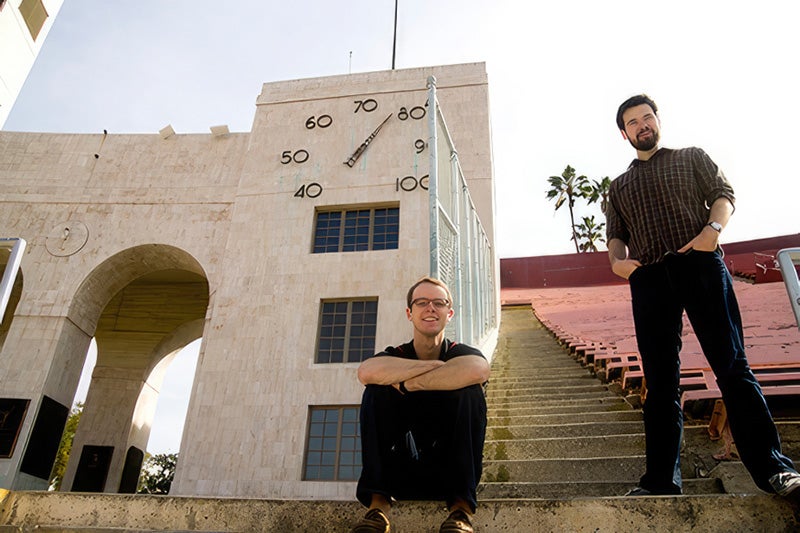
The Coliseum has faithfully fulfilled the vision of its founders: to provide a robust diversity of offerings that gather a wide swath of people. Even the design of the Coliseum’s elliptical bowl reflects this intent.
The great thing was that USC loved the Coliseum — that their history was the Coliseum’s, too.
Linda Dishman
In contrast to more modern stadiums with multiple decks, the bowl has “this big democratic shape where everybody is sitting side by side and cheering on their team,” says Linda Dishman, president and chief executive officer of the Los Angeles Conservancy, who worked with USC during recent renovations to preserve the architectural character of this National and California Historic Landmark.
Dishman notes that over the past 30 years, there have been numerous (unsuccessful) proposals to tear down or dramatically alter the Coliseum to keep up with changing tastes. But when USC began a 98-year lease to manage the Coliseum in 2013, the university saw the value in making improvements with minimal impact on the bowl’s original design. “The great thing was that USC loved the Coliseum — that their history was the Coliseum’s, too,” she says.
Steeped in nostalgia
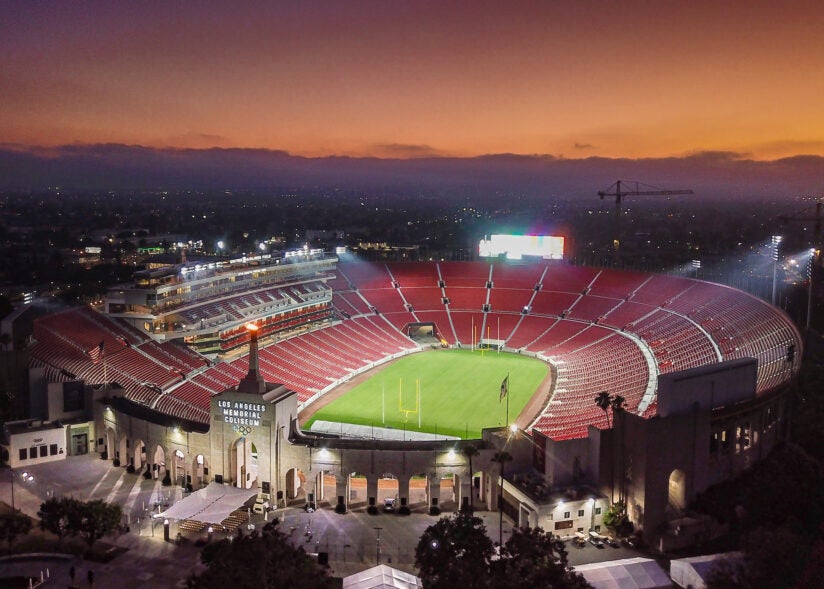
After a $315 million renovation completed in 2019 — which restored the structure to its original glory and added new seats with cupholders, updated concessions and refurbished the Scholarship Club Tower with luxury amenities — the Coliseum stands ready for its next 100 years of history in the making.
Yet even as the centenarian has gotten a makeover, its legacy still whispers through the sweep of the bowl and the arches of the peristyle. In quiet moments when the crowds have gone home, “you can’t help but think of the ghosts of the past, whether it’s Sandy Koufax or John F. Kennedy, or the ‘Thundering Herd’ of some of the great USC teams,” Furin says.
“What makes this place so special, so iconic?” he asks. “It’s that legacy. It’s 100 years of unbelievable events and moments that occurred parallel to a growing Los Angeles — and really connected on a personal level to a lot of generations.”

